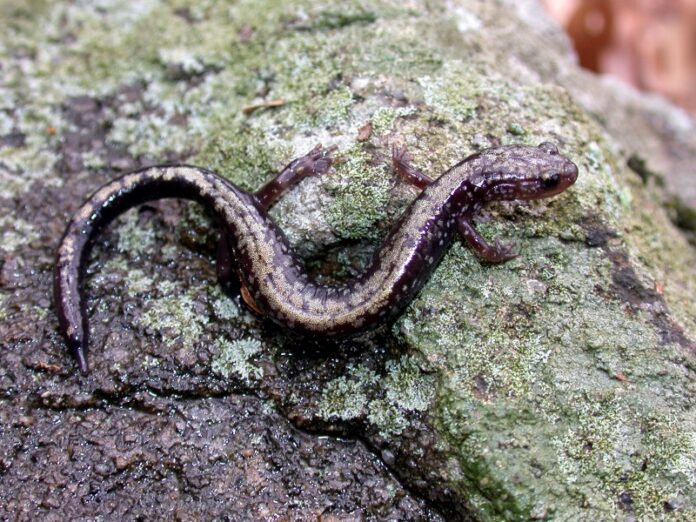
On a cool, crisp evening, Liberty University professors and their students trek through the damp understory of the Jefferson National Forest as the sun falls behind the treeline.
By the time they arrive at their study site among the trees, it is completely dark and lightly drizzling. Equipped with headlamps, they creep along transect lines, scouring the vegetation for glimpses of gold.
They are hunting for the Peaks-of-Otter salamander. Often beginning at eight o’clock and working until one in the morning, they search for the salamander while it hunts for worms and springtails – its invertebrate prey.
Professors Norm Reichenbach, Paul Sattler, Tim Brophy and David Marsh have been working with the U.S. Forest Service and National Park Service to study the Peaks-of-Otter salamander for nearly two decades. Their research not only allows students to experience the species up close, but also helps federal and state agencies to better understand and manage this unique amphibian.
“This is a great partnership that helps secure the future of the Peaks-of-Otter salamander,” Reichenbach said. “Since most of the range of this salamander is in areas managed by the Forest Service and NPS, universities working cooperatively with these agencies can engage in research that aids in the conservation of these species.”
Reichenbach and Marsh study a variety of subjects regarding the species’ ecology, such as how habitat changes like timber harvest might affect the salamander or how other species, like the eastern red-backed salamander, might impact the Peaks-of-Otter salamander.
Known as “sit and wait predators,” this salamander often forages while perched atop forest vegetation, unintentionally revealing itself to the researchers and students that seek to round them up, at least for a little while.
The metallic, brassy flecks that speckle this critter’s dark brown body help the students to identify and grab the salamander before it scoots to a hiding spot under the damp leaves that coat the forest floor.
“You have to see them before they see you,” said Reichenbach, professor of biology at Liberty University.
Because the salamander can also be found under downed logs – or any other place where moisture is naturally trapped and the ground is cool – professors and students spend many hours hunkered over, flipping over anything that may reveal a golden prize.
An hour or less from their classroom, Reichenbach’s students learn about conservation hands on in the biologically rich Appalachians, which just so happens to be right in their backyard.

“You can be in one spot that has one species, walk as little as a few hundred meters, and then find a completely different species,” said Marsh, professor at Washington and Lee University. “You can think of the Southern Appalachians as a sort of salamander Galapagos.”
With a world-wide distribution of only 12 miles, this salamander’s range is contained almost entirely in Virginia’s Peaks-of-Otter region within the Jefferson National Forest and the National Park Service’s Blue Ridge Parkway.
Not to mention, it’s found only at elevations above 1600 ft.
The salamander’s limited range has landed it on the radar of the U.S. Fish and Wildlife Service, which has been working with the National Forest and Park Service to better understand the status of this at-risk species.
The U.S. Forest Service has been managing the Jefferson National Forest with the Peaks-of-Otter salamander in mind for nearly 20 years. In 1997, a conservation agreement between the Forest Service, the U.S. Fish and Wildlife Service, and the National Park Service established primary and secondary conservation areas to guide timber harvesting and manage this sensitive species.
The Peaks-of-Otter salamander, like all plethodon amphibians, has no lungs – breathing entirely through the tissues in its mouth and skin. Preserving adequate canopy cover to prevent the sun from drying out soil and leaf litter is crucial as the salamander relies on adequate ground moisture to keep their skin moist enough to extract oxygen from the air.
In the primary conservation area no trees are cut, and in the secondary area timber harvest activities must meet guidelines for protecting Peaks-of-Otter habitat, such as leaving at least 50 percent of the canopy intact and leaving large woody debris on the ground.
These guidelines were informed by the research of the local professors and students who continue to study the Peaks-of-Otter salamander and its biology on an continuing basis.
“Ongoing research has enhanced our understanding of the species and helped to shape many of the existing management practices in place today,” said Rose Agbalog, Service biologist.
“Partnerships are critical to conservation efforts,” added Fred Huber, retired Forest Botanist for the Jefferson National Forest. “By sharing knowledge, combining resources, and coordinating research, we can move more quickly and effectively to protect species.”
Partnerships like these between universities and federal agencies take the conservation of at-risk species to new heights, potentially precluding the need to list them under the Endangered Species Act. Thanks to the devoted conservation efforts underway, the Peaks-of-Otter salamander is abundant within its limited range.
One night after a recent rain, Reichenbach recalled that the moss-covered boulders along the side of a ridge were strewn with this alluring critter. Huber and Reichenbach found sixty salamanders in just two hours, remembering it fondly as a “fairyland of salamanders.”
“The U.S. Forest Service and the Blue Ridge Parkway have worked for over 20 years to conserve important habitat for the Peaks-of-Otter salamander,” said Agbalog. “With continuing collaboration and conservation efforts from these agencies and local university partners, we hope to secure the future of this unique species.”


